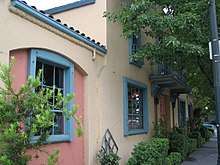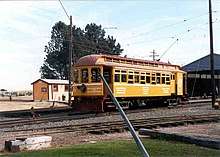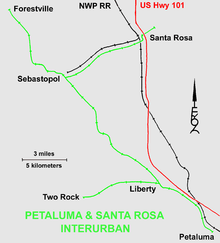Petaluma and Santa Rosa Railroad
Petaluma and Santa Rosa Railroad was a 600 volt DC electric interurban railway[1] in Sonoma County, California, United States. It operated between the cities of Petaluma, Sebastopol, Forestville, and Santa Rosa. Company-owned steamboats provided service between Petaluma and San Francisco.
| Petaluma and Santa Rosa Railroad | ||||||||||||||||||||||||||||||||||||||||||||||||||||||||||||||||||||||||||||||||||||||||||||||||||||||||||||||||||||||||||||||||||||||||||||||||||||||||||||||||||||||||||||||||||||||||
|---|---|---|---|---|---|---|---|---|---|---|---|---|---|---|---|---|---|---|---|---|---|---|---|---|---|---|---|---|---|---|---|---|---|---|---|---|---|---|---|---|---|---|---|---|---|---|---|---|---|---|---|---|---|---|---|---|---|---|---|---|---|---|---|---|---|---|---|---|---|---|---|---|---|---|---|---|---|---|---|---|---|---|---|---|---|---|---|---|---|---|---|---|---|---|---|---|---|---|---|---|---|---|---|---|---|---|---|---|---|---|---|---|---|---|---|---|---|---|---|---|---|---|---|---|---|---|---|---|---|---|---|---|---|---|---|---|---|---|---|---|---|---|---|---|---|---|---|---|---|---|---|---|---|---|---|---|---|---|---|---|---|---|---|---|---|---|---|---|---|---|---|---|---|---|---|---|---|---|---|---|---|---|---|---|
 The Petaluma & Santa Rosa Railroad Station at Railroad Square, Santa Rosa | ||||||||||||||||||||||||||||||||||||||||||||||||||||||||||||||||||||||||||||||||||||||||||||||||||||||||||||||||||||||||||||||||||||||||||||||||||||||||||||||||||||||||||||||||||||||||
| Overview | ||||||||||||||||||||||||||||||||||||||||||||||||||||||||||||||||||||||||||||||||||||||||||||||||||||||||||||||||||||||||||||||||||||||||||||||||||||||||||||||||||||||||||||||||||||||||
| Type | interurban | |||||||||||||||||||||||||||||||||||||||||||||||||||||||||||||||||||||||||||||||||||||||||||||||||||||||||||||||||||||||||||||||||||||||||||||||||||||||||||||||||||||||||||||||||||||||
| Status | dismantled | |||||||||||||||||||||||||||||||||||||||||||||||||||||||||||||||||||||||||||||||||||||||||||||||||||||||||||||||||||||||||||||||||||||||||||||||||||||||||||||||||||||||||||||||||||||||
| Locale | Sonoma County, California | |||||||||||||||||||||||||||||||||||||||||||||||||||||||||||||||||||||||||||||||||||||||||||||||||||||||||||||||||||||||||||||||||||||||||||||||||||||||||||||||||||||||||||||||||||||||
| Technical | ||||||||||||||||||||||||||||||||||||||||||||||||||||||||||||||||||||||||||||||||||||||||||||||||||||||||||||||||||||||||||||||||||||||||||||||||||||||||||||||||||||||||||||||||||||||||
| Track gauge | 4 ft 8 1⁄2 in (1,435 mm) standard gauge | |||||||||||||||||||||||||||||||||||||||||||||||||||||||||||||||||||||||||||||||||||||||||||||||||||||||||||||||||||||||||||||||||||||||||||||||||||||||||||||||||||||||||||||||||||||||
| Electrification | 600 V DC overhead lines | |||||||||||||||||||||||||||||||||||||||||||||||||||||||||||||||||||||||||||||||||||||||||||||||||||||||||||||||||||||||||||||||||||||||||||||||||||||||||||||||||||||||||||||||||||||||
| ||||||||||||||||||||||||||||||||||||||||||||||||||||||||||||||||||||||||||||||||||||||||||||||||||||||||||||||||||||||||||||||||||||||||||||||||||||||||||||||||||||||||||||||||||||||||
Portions of the original right-of-way have been acquired by Sonoma County government for the West County Trail and Joe Rodota Trail, managed by the Sonoma County Regional Parks Department.[2] A portion of the original right-of-way can be found along the waterfront in Petaluma. Efforts have been made by volunteers to re-activate this line to become a trolley line once again.[3]
History
On 20 June 1903 the Santa Rosa Street Railway, the Union Street Railway of Santa Rosa, the Petaluma Street Railroad, and the Central Street Railway were consolidated to form the Petaluma and Santa Rosa Railway. The four consolidated horse car lines built between 1888 and 1891 were to be replaced by an electric railroad operated in conjunction with the Steamer Gold which had been providing ferry service between Petaluma and San Francisco since 1883. A first-spike ceremony was held on 5 April 1904 at the Steamer Gold landing at the foot of Copeland Street. The electric line was completed to Sebastopol in October, and extended along Sebastopol road toward the western edge of Santa Rosa.[4]
The construction crew needed to cross the north-south steam railroad to reach downtown Santa Rosa. The steam railroad had operated a parallel branch line from Santa Rosa to Sebastopol since 1890, and would not consent to the crossing allowing a new competitor to offer direct service downtown. By November the steam railroad stationed guards at the proposed crossing site to prevent cutting of its rails. Trolley service began to the west side of the crossing on 1 December 1904. Rails were laid on the east side of the steam railroad tracks, and an electric wire was strung overhead in preparation for installing the crossing. A threatened boycott of the steam railroad by 92 Santa Rosa merchants had no effect.[4]
The Battle of Sebastopol Road
A crossing was prefabricated in Sebastopol and loaded on a flat car pushed to the crossing location, but when the interurban crew arrived to install the crossing on 3 January 1905, they found a pair of steam locomotives on either side of the crossing fitted with steam nozzles to spray hot water on anyone approaching the crossing site. The interurban construction crew retreated.
The following day the regularly scheduled interurban car #57 arrived secretly carrying the construction crew. Before the steam railway could respond, the crew laid a temporary track across and over the steam rails and had a team of horses pull trolley #57 across to serve downtown Santa Rosa. The steam railroad then obtained a temporary injunction from a San Francisco judge prohibiting installation of the crossing. For a few weeks, passengers from Sebastopol were required to depart their arriving trolley and walk over the steam railroad to reboard trolley #57 for the remainder of the trip.
The injunction was dissolved in late February and the interurban construction crew assembled again to install the crossing on 1 March 1905. The steam railroad appeared to be unaware of the status of their injunction, and so their locomotives again discouraged the construction crew with hot water. A special steam railroad train arrived with 150 San Francisco waterfront thugs hired to discourage the interurban crew. The steam railroad also had a flat car loaded with gravel on hand for their men to fill in the excavation as soon as the interurban crew tried to dig out the crossing site. Tempers flared and several hundred Santa Rosa citizens assembled to watch the entertainment. Santa Rosa police ultimately restored order, and the crossing was installed that evening.[5][6]
Expansion

With the main line from Petaluma to Santa Rosa in operation, a branch line extended service from Sebastopol to Forestville on 15 July 1905. The 1906 San Francisco earthquake cancelled plans for additional extensions to Tomales, Dillon Beach, Geyserville, Healdsburg, Sonoma, Napa, and a closer San Francisco ferry connection on Point Pedro near San Rafael; and completion of a branch line from Liberty to Two Rock was delayed until 28 July 1913. Economic recovery from the quake allowed purchase of the steamer Resolute in 1912, and it was rebuilt as Petaluma to allow two daily ferry connections in 1914. Steamer Gold burned on 29 November 1920 but was replaced by the steamer Fort Bragg (renamed Gold).[4]
Decline
Passenger service on the Two Rock branch was discontinued on 30 September 1925 after monthly passenger revenues on the branch dropped from $400 to $27.[4] A new passenger and freight depot was built in Santa Rosa in 1927.[7] The Santa Rosa line was dismantled from McDonald Avenue to Olive Street in 1931.[8] The Petaluma & Santa Rosa was purchased by Northwestern Pacific Railroad (NWP) in 1932 and all trolley passenger service ended on July 1 of that year. Ferry passenger service was discontinued in 1935, but both ferries continued to carry freight until Gold was scrapped in 1940. Petaluma made the last ferry trip on 24 August 1950.[4] The Santa Rosa line was dismantled from Olive Street to Stop 45 junction with the NWP Sebastopol branch in 1946 and from Stop 45 to Leddy junction with the NWP branch in 1947.[9] Electric operation ended when Motor #1008 brought a carload of horses to Liberty on 24 January 1947. Diesel locomotives replaced the electric motors which were burned at Sacramento on 15 March 1947.[4] The Two Rock branch was dismantled in 1952, and the Forestville line was shortened by 1-mile (1.6 km) to Ross in 1961. Southern Pacific Railroad diesel locomotives replaced the last Petaluma and Santa Rosa diesel in 1966. The Forestville line was shortened by another mile to Sagu in 1969. Eight miles of track were abandoned between Denman and Turner in 1973, and four more miles of track were abandoned between Turner and Alten in 1978. Sonoma County supervisors directed the parks department to acquire portions of the abandoned right-of-way as the line from Santa Rosa to Sebastopol was abandoned between 1984 and 1989. NWP continued using the southern end of the line to serve local industries in Petaluma.[10]
Route

From south to north:
- Milepost 0 - Petaluma
- Milepost 3.6 - Denman
- Milepost 5.1 - Liberty - branch west to: Cherry (MP 7.7) and Two Rock (MP 10.4)
- Milepost 7.9 - Stony Point
- Milepost 9.4 - Roblar
- Milepost 9.6 - Quarry
- Milepost 10.9 - Orchard
- Milepost 11.3 - Turner
- Milepost 13.2 - Cunningham
- Milepost 14.9 - Alten
- Milepost 16.7 - Sebastopol - branch east to: Leddy (MP 20.2), Stop 45 (MP 22.6), and Santa Rosa (MP 23.4)
- Milepost 20.9 - Graton
- Milepost 23.8 - Forestville
Roster of passenger rolling stock
| Number | Builder | Type | Date | Length | Notes |
|---|---|---|---|---|---|
| 51 | American Car Company | Motor | 1904 | 47 ft 9 in | retired 1933[11][12] |
| 53 | American Car Company | Motor | 1904 | 47 ft 9 in | retired 1933[13][14] |
| 55 | American Car Company | Motor | 1904 | 47 ft 9 in | became inspection car in 1932 retired 1941[15][16] |
| 57 | American Car Company | Motor | 1904 | 47 ft 9 in | became inspection car in 1932 retired 1941[17][18] |
| 59 | W. L. Holman Car Company | Motor | 1904 | 44 ft | retired 1932[19] |
| 61 | W. L. Holman Car Company | Motor | 1904 | 44 ft | retired 1932[20] |
| 63 | W. L. Holman Car Company | Motor | 1904 | 44 ft | retired 1932 preserved Western Railway Museum[21] |
| 65 | W. L. Holman Car Company | Motor | 1904 | 44 ft | retired 1932[22] |
| 67 | W. L. Holman Car Company | Motor | 1904 | 44 ft | retired 1932[12][23] |
| 69 | W. L. Holman Car Company | Motor | 1904 | 44 ft | converted to express trailer in 1919 retired 1932[16][24] |
| 71 | W. L. Holman Car Company | Trailer | 1905 | 44 ft | retired 1929 |
| 73 | W. L. Holman Car Company | Trailer | 1905 | 44 ft | retired 1929 |
| 01 | W. L. Holman Car Company | Express Trailer | 1916 | built as #8 express motor demotorized 1917 designated express trailer 1920 retired 1933[21][25] |
Roster of freight motors
| Number | Builder | Type | Date | Works Number | Notes |
|---|---|---|---|---|---|
| 8 | W. L. Holman Car Company | Express Motor | 1916 | demotorized as line car #4 in 1917 redesignated express trailer #01 in 1920[26] | |
| 100 | Baldwin Locomotive Works | Motor | 1912 | leased from Southern Pacific Railroad Company 1933-1941[25][27] | |
| 502 | American Car Company | Motor | 1917 | purchased from Kansas City - Kays Valley Railroad 1920 retired 1946[28][29] | |
| 504 | Ocean Shore Railroad | Motor | 1917 | purchased from Ocean Shore Railroad 1921 retired 1947[30][31] | |
| 506 | Petaluma & Santa Rosa RR | Motor | 1923 | built from Sacramento Northern Railroad frame #1000 with motors from Ocean Shore Railroad retired 1947[29][32] | |
| 1002 | W. L. Holman Car Company | Motor | 1904 | rebuilt as steeple cab in 1920 and as cabless multiple unit slave #1004B in 1928 retired 1947 | |
| 1004 | W. L. Holman Car Company | Motor | 1904 | rebuilt as steeple cab in 1920 and renumbered 1004A with multiple unit controls in 1928 retired 1947[33][34] | |
| 1006 | W. L. Holman Car Company | Motor | 1904 | rebuilt as steeple cab in 1920 and as cabless multiple unit slave #1008B in 1929 retired 1947[33] | |
| 1008 | W. L. Holman Car Company | Motor | 1904 | rebuilt as steeple cab in 1920 and renumbered #1008A with multiple unit controls in 1929 retired 1947[33][34] | |
| 1010 | Petaluma & Santa Rosa R.R. | Motor | 1917 | Flat car rebuilt with motors from Express Motor #8 sold to City of San Francisco 1921 repurchased 1930 retired 1947[33][34] | |
| 1 | General Electric | GE 44-ton switcher | 1946 | 28338 | became Southern Pacific Railroad #1904 in 1958[35] |
| 2 | General Electric | GE 44-ton switcher | 1942 | 15034 | ex-Lehigh Valley Railroad #61 then Rio Grande and Eagle Pass Railroad #10 acquired 1946 became Southern Pacific Railroad #1905 in 1958[25][35] |
| 3 | General Electric | GE 44-ton switcher | 1943 | 17928 | built as San Francisco and Napa Valley Railroad #50 for work in the Mare Island Naval Shipyard; became Southern Pacific #203 in 1956;[36] acquired 1958; retired 1964 |
| 4 | General Electric | GE 44-ton switcher | 1945 | 27817 | ex-Southern Pacific #1903 acquired 1958 retired 1966 |
The company roster included 89 conventional freight cars (unpowered trailers) in 1931.[37]
See also
- Petaluma and Santa Rosa Railway Powerhouse
- William Ashburner Cattell (1803-1920), president, Petaluma and Santa Rosa Railroad[38]
Sources
- Borden, Stanley T. (1960). Petaluma & Santa Rosa Electric R.R. The Western Railroader.
- Demoro, Harre W. (1986). California's Electric Railways. Glendale, California: Interurban Press. ISBN 0-916374-74-2.
- Schmale, John & Kristina (2009). Petaluma And Santa Rosa Railroad, CA (Images of Rail). Arcadia Publishing. ISBN 978-0-7385-5959-9.
- Stindt, Fred A. (1985). The Northwestern Pacific Railroad Volume Two. Fred A. Stindt. ISBN 0-9615465-0-6.
Notes
- Demoro 1986 p.15
- "West County and Joe Rodota Trails". Retrieved 2007-12-10.
- Carter, Lori A. (2014-12-01). "Petaluma trolley dream pursued by pair". Press Democrat. Retrieved 10 November 2017.
- Ellison, Robert; Sievers, Walt (1952). "Petaluma and Santa Rosa Railroad Company". The Western Railroader. Francis A. Guido. 15 (148): 3–14.
- Borden 1960 pp.11-12
- Stindt 1985 pp.105 & 108
- Borden 1960 p.25
- Borden 1960 p.26
- Borden 1960 pp.26 & 31
- Stindt 1985 p.129
- Stindt 1985 pp.109-110 & 114
- Borden 1960 p.19
- Stindt 1985 p.110
- Borden 1960 p.17
- Stindt 1985 pp.107 & 119
- Borden 1960 p.20
- Stindt 1985 pp.104,111 & 119
- Borden 1960 pp.20-21
- Stindt 1985 p.111
- Stindt 1985 pp.109 & 111
- Stindt 1985 p.118
- Stindt 1985 pp.105 & 111
- Stindt 1985 pp.113 & 118
- Stindt 1985 p.122
- Borden 1960 p.27
- Stindt 1985 p.116
- Stindt 1985 p.124
- Stindt 1985 p.125
- Borden 1960 p.22 & 29
- Stindt 1985 pp.120-122 & 125
- Borden 1960 p.29
- Stindt 1985 p.117,122 & 125
- Stindt 1985 p.126
- Borden 1960 p.28
- Stindt 1985 p.127
- Cross, Carol W. (1974). "Railroading Era Comes To A Close". The Western Railroader. Francis A. Guido. 37 (408): 3–10.
- Demoro 1986 p.201
- American Society of Civil Engineers (1921). Transactions of the American Society of Civil Engineers (Public domain ed.). American Society of Civil Engineers. pp. 820–.
External links
- Western Railway Museum which has restored and operates P&SR car #63.
- Petaluma Trolley which has restored P&SR car #8.
- Northwestern Pacific Railroad Historical Society is restoring P&SR caboose #1.
- West County Trail
- Map of the Petaluma and Santa Rosa Railroad